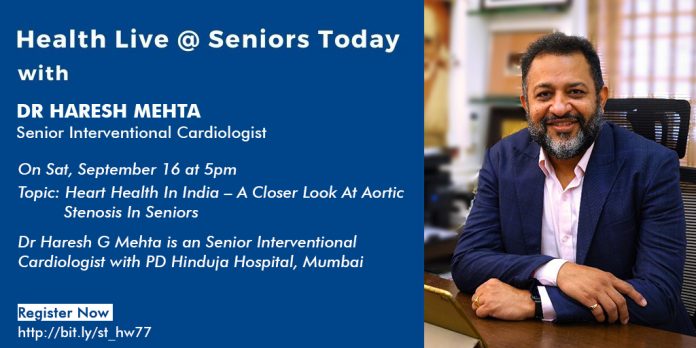Reading Time: 3 minutes
On 16 Sep, 2023, Seniors Today hosted their weekly Health Live webinar with Dr Haresh Mehta, a Senior Interventional Cardiologist with Hinduja Healthcare Surgical, Mumbai. Dr Haresh Mehta spoke about and answered questions regarding Heart Health In India – A Closer Look At Aortic Stenosis In Seniors
About Dr Haresh Mehta
Dr. Haresh G Mehta is an Interventional Cardiologist with nearly 20 years of well-rounded clinical, scientific, research and academic experience. He is a fellow at King’s Hospital (London), Lennox Hill Hospital (New York) and Hanusch University Hospital (Vienna).
He is a regular on the global lecture circuit, where he offers his expertise and skill in teaching and training. Dr. Mehta has presented papers at many international events and conferences, including the American Heart Association and the Cardiology Society of India, among others.
Dr Mehta has been published, as an author and co-author, in some of the most prestigious cardiology publications in the world. He got trained as an independent implanter in the TAVR technique (percutaneous aortic valve replacement).
The human heart, as its primary function, pumps blood. It pumps blood to provide oxygen and nutrients to the various parts of the body, through the good blood/ red blood/ oxygenated blood. But it also removes all the bad blood/ deoxygenated blood from the body and brings it back to the lungs for purification.
The heart never stops.
There are 4 chambers of the heart, 2 to the right- right atrium and right ventricle which carries the impure blood. And 2 to the left- the left atrium and the left ventricle which carries the good blood to the body.
Valves are doors which allow the blood to flow in only one direction, and prevents it from coming back.
Between the atrium and the ventricle, there is a door in between. On the right side it is called tricuspid valve and on the left side of the heart, its called the mitral valve.
The right ventricle pumps bad blood to the lungs, thus there is a pulmonary valve.
The left ventricle pumps blood to the body through the aorta, thus there is an aortic valve present.
Stenosis is the narrowing of the valves of the heart. This makes it difficult for the blood to pass through. Thereby increasing the load on the heart, by making the heart work harder to pump the blood out into the body.
If this is left untreated, it can lead to-
- Swelling of the feet
- Difficulty in walking
- Difficulty in breathing
- Heart failure
Aortic valve is the valve/ door which is present between the left ventricle and the aorta which supplies blood to the entire body.
The aortic valve has 3 cusps or leaflets. And when there is deposition of calcium around these leaflets, the valves become narrow and makes it difficult to open.
Causes of aortic stenosis:
- Abnormal valve. Occasionally, instead of the normal 3 leaflets, there can be only 2 or 1 leaflet. Sometimes there can even be 4. Such individuals can present in their 5th/ 6th decade
- Narrowing of the valve due to age resulting in calcium buildup is the commonest cause
- Age- 70-80 years
- Rheumatic fever- commonest cause of aortic stenosis in young adults
- Patients undergoing radiation therapy as a part of their cancer treatment can too, rarely develop aortic stenosis as a result scar formation
Signs and symptoms of aortic stenosis:
- It is usually missed, because these individuals do not complain of any problems, initially. And by the time the symptoms appear, the disease has progressed
- Undue tiredness/ fatigue
- Dizziness/ fainting
- Angina/ tightness in the chest
- Breathlessness
- Palpitations
- Swelling in the legs
Diagnosis of aortic stenosis:
- General examination
- Vitals such as pulse, BP
- Auscultation- can present as a murmur
- ECG
- Echocardiogram
- Stress test
Treatment modalities:
- Mild to moderate aortic stenosis: these patients are treated with pharmacological management. No other intervention is required. Regular 3 monthly/ 6 monthly/ yearly follow ups are advised as per the severity of the disease.
- Severe aortic stenosis:
- Balloon valvuloplasty- done as a palliative treatment in young patients. Or in Beverly ill patients who cannot undergo surgery
- Open heart surgeries- can use mechanical or bioprosthetic valves
Mechanical valves are preferred in young patients or individuals who are suffering from rheumatic heart disease. Patients with mechanical valves need to be put on strong blood thinning agents and need to be monitored closely.
Bioprosthetic valves degrade over time and can require replacement.
- TAVR: a therapy involving replacing the valve without surgery. More than 5 % of senior patients are at high risk for surgeries.
This therapy was first performed in 2001.
The valve is replaced like we do an angioplasty, where we enter the heart through the groin, go to the aorta, enter the aortic valve and place the aortic valve over a balloon.
Advantages: can be donning patients who are high risk for surgery
No anaesthesia is required
Minimally invasive
Short procedure time and hospital stay duration (sometimes even 1 day stay)
Recovery is fast
The valve starts acting immediately








